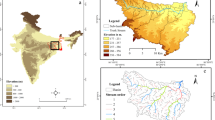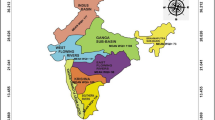Abstract
In this paper, the spatial distributions and temporal changes of electrical conductivity (EC) and pH in the Sungun mining area (in the East Azarbayjan province, Iran) were assessed. These variables were measured in 2005 in three parts of the mine considered for: the mining pit, waste dump, and tailings dam. A follow-up study was devised in 2016 with a new sampling round, at almost the same locations to examine the environmental status of the study area and its changes during this time interval. First, the general statistical evaluations were conducted. After distribution assessments and spatial variability modeling, the EC and pH were predicted at unsampled locations using three geostatistical methods of kriging, Sequential Gaussian Simulation, and Bayesian Maximum Entropy (BME). BME can also efficiently take the soft information into account. Moreover, the predicted variables and their estimation variances were mapped using these methods. The hazardable zones on these maps were also noted.



















Similar content being viewed by others
References
Agbenyeku EOE, Muzenda E, Msibi MI (2016) Chemical alterations in three clayey soils from percolation and interaction with acid mine drainage (AMD). S Afr J Chem Eng 21:28–36
Aghazadeh M, Hou Z, Badrzadeh Z, Zhou L (2015) Temporal–spatial distribution and tectonic setting of porphyry copper deposits in Iran: constraints from zircon U-Pb and molybdenite Re–Os geochronology. Ore Geol Rev 70:385–406
Aini IN, Ezrin MH, Aimrun W (2014) Relationship between soil apparent electrical conductivity and pH value of Jawaseries in oil palm plantation. Agric Agric Sci Procedia 2:199–206
Argyraki A, Kelepertzis E, Botsou F, Paraskevopoulou V, Katsikis I, Trigoni M (2018) Environmental availability of trace elements (Pb, Cd, Zn, Cu) in soil from urban, suburban, rural and mining areas of Attica, Hellas. J Geochem Explor 187:201–213
Asghari O (2015) Geostatistical simulation of dyke systems in Sungun porphyry copper deposit, Iran. J Min Environ 6(1):1–10
Bayat B, Zahraie B, Taghavi F, Nasseri M (2013) Evaluation of spatial and spatiotemporal estimation methods in simulation of precipitation variability patterns. Theor Appl Climatol 113(3–4):429–444
Bidhendi GN, Karbassi AR, Nasrabadi T, Hoveidi H (2007) Influence of copper mine on surface water quality. Int J Environ Sci Technol 4(1):85–91
BMElab Department of Environmental Sciences and Engineering School of Public Health, University of North Carolina (2014) BMEGUI3.0.1 User Manual. Retrieved from https://mserre.sph.unc.edu/BMEGUI_web/BMEGUI3.0.1_web/BMEGUI3.0.1_DOCs/PDF/BMEGUI3.0.1_UserManual_v01.pdf
Carroll SS, Cressie N (1996) A comparison of geostatistical methodologies used to estimate snow water equivalent. JAWRA J Am Water Resour Assoc 32(2):267–278
Christakos G (1990) A Bayesian/maximum-entropy view to the spatial estimation problem. Math Geol 22(7):763–777
Christakos G (2000) Modern spatiotemporal geostatistics, vol 6. Oxford University Press, Oxford
Christakos G, Li X (1998) Bayesian maximum entropy analysis and mapping: a farewell to kriging estimators? Math Geol 30(4):435–462
Coburn TC (2000) Geostatistics for natural resources evaluation. Technometrics 42(4):437
D’Or D (2003) Spatial prediction of soil properties, the Bayesian Maximum Entropy approach. PhD, Université Catholique de Louvain
De Iaco S, Maggio S, Palma M, Posa D (2012) Advances in spatio-temporal modeling and prediction for environmental risk assessment. In: Haryanto B (ed) Air pollution—a comprehensive perspective. InTech, Croazia, pp 365–390
Deutsch CV, Journel AG (1998) GSLIB: geostatistical software library and user’s guide. Oxford University Press, New York
Diringer SE, Berky AJ, Marani M, Ortiz EJ, Karatum O, Plata DL, Pan WK, Hsu-Kim H (2019) Deforestation due to artisanal and small-scale gold mining exacerbates soil and mercury mobilization in Madre de Dios, Peru. Environ Sci Technol 54(1):286–296
Douaik A, Van Meirvenne M, Tóth T (2005) Soil salinity mapping using spatio-temporal kriging and Bayesian maximum entropy with interval soft data. Geoderma 128(3–4):234–248
Fugiel A, Burchart-Korol D, Czaplicka-Kolarz K, Smoliński A (2017) Environmental impact and damage categories caused by air pollution emissions from mining and quarrying sectors of European countries. J Clean Prod 143:159–168
Goovaerts P (1997) Geostatistics for natural resources evaluation. Oxford University Press, Oxford
Hamzehpour N, Bogaert P (2017) Improved spatiotemporal monitoring of soil salinity using filtered kriging with measurement errors: an application to the West Urmia Lake. Iran. Geoderma 295:22–33
He J, Kolovos A (2018) Bayesian maximum entropy approach and its applications: a review. Stoch Environ Res Risk Assess 32(4):859–877
Hosseini SZ, Kappas M, Bodaghabadi MB, Zare Chahouki MA, Khojasteh ER (2014) Comparison of different geostatistical methods for soil mapping using remote sensing and environmental variables in Poshtkouh Rangelands, Iran. Pol J Environ Stud 23(3):737–751
Isaaks EH, Srivastava RM (1989) An introduction to applied geostatistics. Oxford University Press, Oxford
Journel AG, Huijbregts CJ (1978) Mining geostatistics, vol 600. Academic Press, London
Kellogg CE (1993) Soil survey division staff: soil survey manual. United States Department of Agriculture, Washington, DC
Le ND, Zidek JV (2006) Spatial prediction: classical approaches. In: Statistical analysis of environmental space-time processes, pp 101–117. Springer Series in Statistics. Springer, New York, NY. https://doi.org/10.1007/0-387-35429-8_7
Modis K, Vatalis K, Papantonopoulos G, Sachanidis C (2010) Uncertainty management of a hydrogeological data set in a greek lignite basin, using BME. Stoch Environ Res Risk Assess 24(1):47–56
Moore F, Esmaeili K, Keshavarzi B (2011) Assessment of heavy metals contamination in stream water and sediments affected by the Sungun porphyry copper deposit, East Azerbaijan Province, Northwest Iran. Water Qual Expo Health 3(1):37–49
Obso TK (2006) Ecophysiological diversity of wild Arabica coffee populations in Ethiopia: groth, water relations and hydraulic characteristics along a climatic gradient, vol 46. Cuvillier Verlag, Göttingen
Pedretti D, Mayer KU, Beckie RD (2020) Controls of uncertainty in acid rock drainage predictions from waste rock piles examined through Monte-Carlo multicomponent reactive transport. Stoch Environ Res Risk Assess 34(1):219–233
Richards LA (1969) Diagnosis and improvement of saline and alkali soils. United States Department of Agriculture, Washington, DC
Shannon CE (1948) A mathematical theory of communication. Bell Syst Tech J 27(3):379–423
Talebi H, Asghari O, Emery X (2013) Application of plurigaussian simulation to delineate the layout of alteration domains in Sungun copper deposit. Open Geosci 5(4):514–522
Yang Y, Wu J, Christakos G (2015) Prediction of soil heavy metal distribution using Spatiotemporal Kriging with trend model. Ecol Indic 56:125–133
Yant M (2009) Hydrothermal alteration. www.indiana.edu. Indiana University, viewed 28 June 2020. https://sierra.sitehost.iu.edu/papers/2009/yant.html
Yao RJ, Yang JS, Shao HB (2013) Accuracy and uncertainty assessment on geostatistical simulation of soil salinity in a coastal farmland using auxiliary variable. Environ Monit Assess 185(6):5151–5164
Zhang CT, Yang Y (2019) Improving the spatial prediction of soil Zn by converting outliers into soft data for BME method. Stoch Environ Res Risk Assess 33(3):855–864
Zhao Y, Lei J, Tumarbay H, Xue J (2018) Using sequential Gaussian simulation to assess the uncertainty of the spatial distribution of soil salinity in arid regions of Northwest China. Arid Land Res Manag 32(1):20–37
Žibret G, Gosar M, Miler M, Alijagić J (2018) Impacts of mining and smelting activities on environment and landscape degradation—Slovenian case studies. Land Degrad Dev 29(12):4457–4470
Zürcher L, Bookstrom AA, Hammarstrom JM, Mars JC, Ludington S, Zientek ML, Dunlap P, Wallis JC, Drew LJ, Sutphin DM, Berger BR (2015) Porphyry copper assessment of the Tethys region of western and southern Asia: chapter V in Global mineral resource assessment (No. 2010-5090-V). US Geological Survey
Acknowledgements
We would like to thank the Sungun copper-molybdenum mine staff for their support during the sampling stage of this study. We sincerely thank the former head of Sungun mine Research Office, Engineer Ali Esmaeilnejad, and his colleagues. We also would like to express our respect to Dr. Dimitri D’Or (currently Chief Science Officer, Ephesia Consult) for his kind permission to use a graph from his dissertation and a special thanks to Engineer Jamshid Jafari Tabrizi (a retired scientific staff of the Faculty of Mining Engineering, Sahand University of Technology, Tabriz, Iran) for providing information and data from the first sampling step. Undoubtedly, we could not have reached our research aims without Engineer Mohammad Qasemi’s serious attempts who devotedly and accurately devised the sampling tools and did the sampling in the second phase (2016) during his study as a BSc student of the mining engineering at the Faculty of Mining Engineering, Sahand University of Technology in Tabriz, Iran.
Author information
Authors and Affiliations
Corresponding author
Additional information
Publisher's Note
Springer Nature remains neutral with regard to jurisdictional claims in published maps and institutional affiliations.
Rights and permissions
About this article
Cite this article
Rezaei, S., Ranjineh Khojasteh, E. & Faridazad, M. Improving geostatistical predictions of two environmental variables using Bayesian maximum entropy in the Sungun mining site. Stoch Environ Res Risk Assess 34, 1775–1794 (2020). https://doi.org/10.1007/s00477-020-01863-4
Published:
Issue Date:
DOI: https://doi.org/10.1007/s00477-020-01863-4




